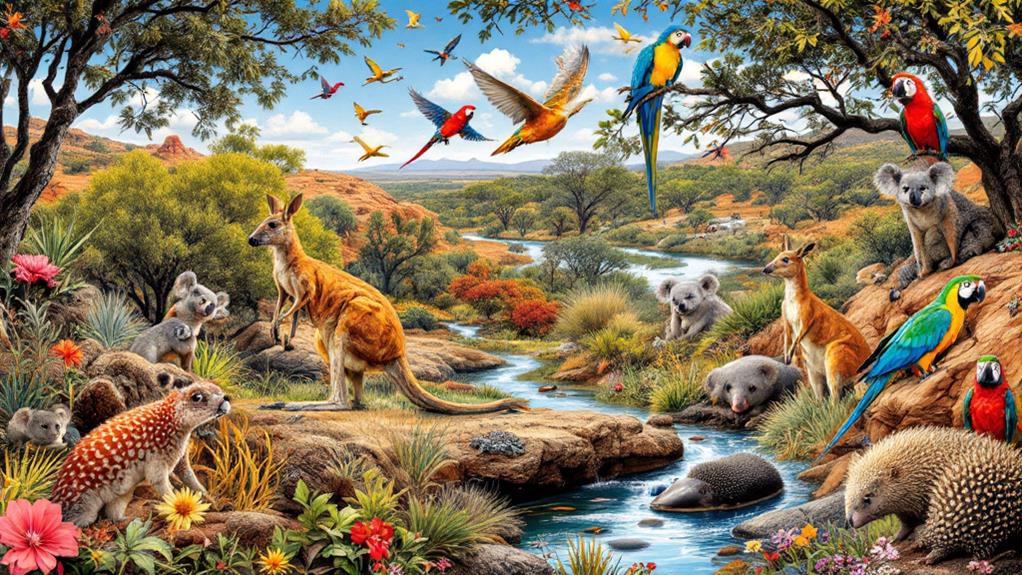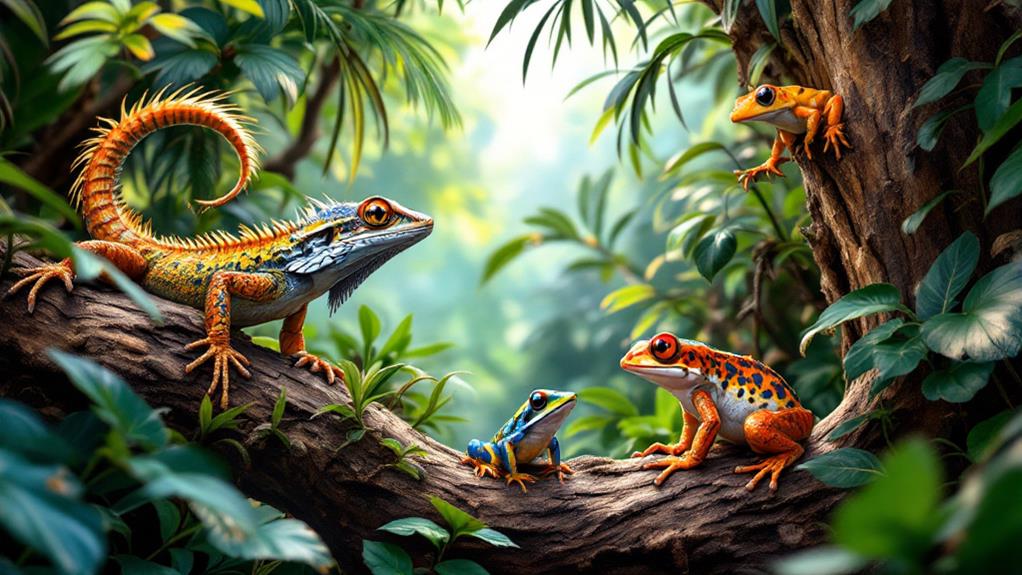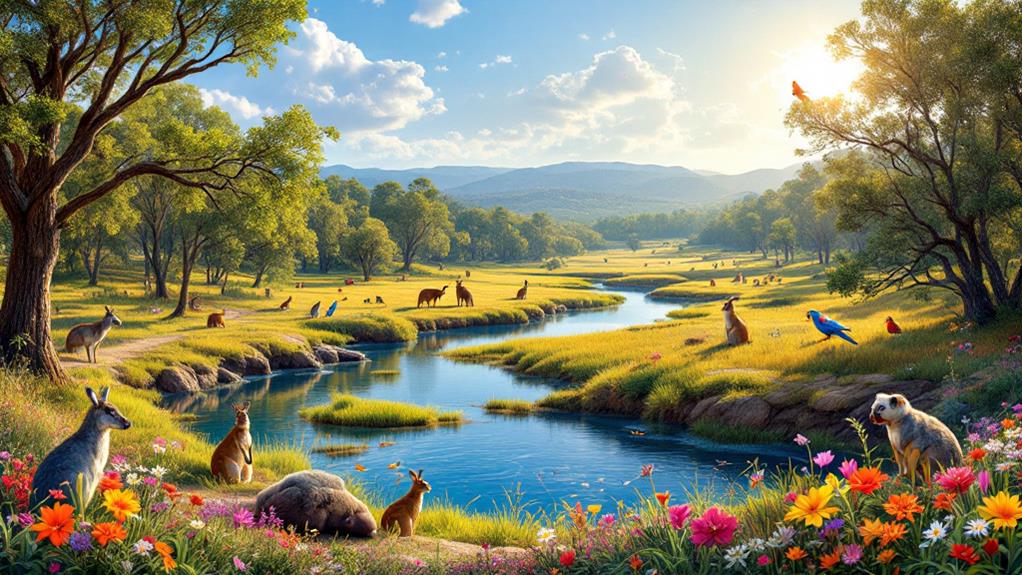What Animals Live in Australia? A Guide to Unique Wildlife

You'll uncover an amazing variety of unique animals in Australia. Iconic marsupials like the red kangaroo and koala call this land home. Keep an eye out for the wombat, famous for its digging skills. Bird enthusiasts will be thrilled by the laughing kookaburra and the flightless emu. Don't forget reptiles like the color-changing thorny devil and amphibians such as the lively green tree frog. With species like the Northern hairy-nosed wombat facing threats, conservation is essential. Fantastic wildlife viewing spots abound, from Kangaroo Island to the Great Barrier Reef. There's so much more to reveal about Australia's remarkable wildlife.
Iconic Australian Marsupials
When you think of Australia, it's hard not to picture its iconic marsupials that are both fascinating and distinctive. Kangaroos, koalas, and wombats are just a few of the remarkable creatures that call this vast land home. Among these, the red kangaroo stands out as the largest species, boasting impressive agility and powerful hind legs that allow it to cover great distances with ease. These giant marsupials are a symbol of the Australian outback, embodying the rugged beauty of their environment.
Koalas, on the other hand, lead a more tranquil life. These cuddly marsupials spend up to 20 hours a day cradled in eucalyptus trees, living off a diet of eucalyptus leaves. Despite their sleepy demeanor, koalas are specially adapted to their treetop homes, relying on a specialized diet that sustains them in the wild.
Then there are wombats, stout and sturdy, known for their impressive digging capabilities. With powerful limbs and long claws, they create extensive burrow systems. These remarkable Australian animals can run up to 25 mph when needed, showcasing their surprising speed. Each of these marsupials represents a fascinating piece of Australia's rich biodiversity.
Fascinating Native Birds
Australia's birdlife is a demonstration to the continent's unique biodiversity, with its avian species offering a vivid display of nature's creativity. With approximately 800 bird species, around 350 are endemic, showcasing a remarkable diversity of native birds that are both intriguing and diverse.
- Laughing Kookaburra: This iconic bird is famous for its distinctive call that echoes through woodlands. Often heard in communal calls, the Laughing Kookaburra uses its voice to establish family territories, making it a staple of Australia's wildlife.
- Albert's Lyrebird: Found primarily in southeastern rainforests, Albert's Lyrebird is a master of mimicry. It's renowned for reproducing a wide array of sounds, from other birds' calls to man-made noises, highlighting its unique role in avian diversity.
- Emu: As the world's second-largest bird, the Emu stands out with its impressive stature, reaching heights of up to 1.9 meters. Flightless yet formidable, the Emu relies on powerful legs to sprint at speeds up to 50 km/h, embodying the robust nature of Australia's native birds.
- Southern Cassowary: Resembling a modern dinosaur, this bird is noted for its impressive jumping ability, leaping up to 1.5 meters high, further contributing to the continent's unique wildlife.
Unique Reptiles and Amphibians

Australia often surprises with its incredible array of unique reptiles and amphibians, each adapted to plunge in diverse environments. Among these remarkable creatures is the Thorny Devil, a fascinating lizard capable of changing color to blend into its surroundings. It thrives in arid environments by collecting water through grooves in its skin. The Fitzroy River Turtle boasts an extraordinary ability to breathe through its backside, allowing it to remain submerged for up to 21 days, a true marvel of native wildlife.
When it comes to amphibians, Australia is home to around 180 species of frogs, including the lively Green Tree Frog. This amphibian, with its bright green hue, inhabits a variety of habitats, adding a splash of color to the landscape.
Australia also hosts some of the most venomous snakes on the planet. The Inland Taipan, or the "fierce snake," holds the title of the world's most venomous snake, delivering a potentially lethal dose of venom in just one bite. Meanwhile, the Eastern Brown Snake is notorious for causing more bites in Australia than any other snake, often appearing in urban areas. Each of these unique reptiles and amphibians showcases Australia's incredible biodiversity.
Threatened and Endangered Species
Amid Australia's breathtaking biodiversity, a staggering number of species are teetering on the brink of extinction. Nearly one in three unique mammals face the threat of disappearing forever, primarily due to habitat loss and the introduction of invasive species. To address this crisis, conservation efforts are essential. Here's what you need to know:
- Critically Endangered Species: Currently, 86 native flora and fauna species in Australia are classified as critically endangered, underscoring the urgent need for action.
- Endangered Mammals: The northern hairy-nosed wombat and numerous potoroo species are among those affected by shrinking habitats and competition from invasive predators like feral cats and foxes.
- Greater Bilby: Once widespread, the Greater Bilby now finds itself vulnerable. Conservation initiatives are focusing on restoring habitats and raising public awareness to help save this unique species.
- Impact of Invasive Species: Invasive species have been a significant factor in the decline of native wildlife populations. Management and protection strategies are necessary to curb their impact.
Best Wildlife Viewing Spots

For nature enthusiasts seeking unforgettable wildlife encounters, the diverse landscapes of Australia offer some of the world's best plunging spots. Kangaroo Island is a must-visit, renowned for its diverse wildlife, including koalas, kangaroos, and the remarkable Australian sea lions. Here, Flinders Chase National Park provides a significant habitat for these creatures, making it an ideal spot for wildlife viewing in their natural environment.
Queensland's Great Barrier Reef is another prime destination, where you can immerse yourself in lively marine life. It's a breathtaking experience to snorkel or plunge among lively fish and six species of sea turtles. This underwater paradise is perfect for those who cherish unique marine wildlife.
In the lush Daintree Rainforest, also in Queensland, you'll encounter the elusive cassowary and a dazzling array of colorful butterflies. This ancient forest offers a serene setting for observing unique wildlife up close.
Lastly, Cradle Mountain National Park in Tasmania is a haven for spotting wombats and the elusive Tasmanian devils, particularly at dusk when they become most active. Regardless of if you're on land or underwater, Australia's diverse ecosystems promise unforgettable wildlife experiences for nature enthusiasts.
Responsible Wildlife Interaction
While exploring the stunning wildlife spots in Australia, it's just as essential to engage in responsible wildlife interaction. By doing so, you not only protect the native species but also preserve their natural habitats. Here's how you can make a positive impact:
- Maintain Distance: Always keep a safe distance from wildlife. This helps avoid stressing the animals and allows them to continue their natural behaviors undisturbed.
- Avoid Feeding Native Animals: Feeding wildlife can lead to dependency on human food, which disrupts their natural foraging habits. Stick to observing rather than interacting.
- Respect the Habitat: Be mindful of nesting sites and breeding grounds. Disturbing these areas can have severe consequences for the survival of many species.
- Use Eco-Friendly Products: Opt for biodegradable sunscreens and insect repellents to reduce your environmental impact. These eco-friendly products guarantee that you're not harming the ecosystem while enjoying your visit.
Joining guided tours led by professionals who follow ethical practices can improve your experience. These tours provide education on responsible wildlife interactions and often include visits to wildlife sanctuaries. By adopting these methods, you contribute positively to the preservation of Australia's unique wildlife and guarantee future generations can enjoy the same wonders.




